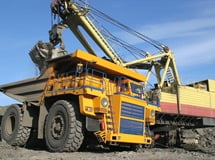MINING is big business in Australia and it comes with a set of challenges you don’t find in typical commercial applications. There are the obvious challenges of installing electronic solutions in remote locations but the sites themselves aren’t easy.
Things like comms and power all quail under the tyranny of distance when it comes to open pit mining. In areas like the Hammersley Range and Darling Downs, mine sites are measured in tens of kilometres and securing them in traditional ways is difficult, if not impossible.
With vast perimeters, fencing and mobile patrols take the place of electronic perimeter security solutions at site edges and security is brought closer in, with a heavy focus on access control and video surveillance supported by radar and thermal imaging technology. When it comes to mines, access control doesn’t just include people – there are massive Caterpillar 797F mining trucks, trains a kilometre long and huge bulk carriers to take into account if your responsibility stretches across multiple sites, including ports.
Video surveillance has a major role to play and allows security patrols to respond more efficiently to incidents on mine sites. As well as scanning perimeters and pits, operators can monitor entry points, roadways, and major plant operations including conveyors, jetslingers and telescopic chutes. When operations move underground things can be more complicated still and installers will be relying on preinstalled infrastructure to support their equipment.
There’s an OH&S component here, too. Modern mines run very efficiently with a single operator handling train loading for an entire mine site, depending on the capacity of the facility. Capable electronic security solutions allow automated mining operations to be conducted in the safest possible way. That means only staff with a proper level of training and expertise are allowed to access given areas and they must be properly equipped.
If you’ve seen images of the iron ore operations at Mount Tom Price something else that’s obvious is that mining operations are heard on electronics. They are most of all dusty, they are extremely hot, there are vibrations, large sources of power and plenty of EMI and RFI around.
Also important to police are dangerous chemicals used in the mining process and video surveillance and open ground detection solutions like radar can be used to handle this task.
A particular issue for security managers and installers is low light performance. Lighting on very large industrial operations is expensive and that means a camera with excellent low light capability or a thermal component is a real blessing on a mine site. Low light capability is important underground where use of video surveillance to monitor operational efficiency and worker safety.
Anything installed outside the administration buildings of a mine site should be rated for external applications. Even if a camera or reader is installed under cover of a roofline in a workshop, it’s not likely the location will be completely enclosed and there will be all-enveloping dust. It goes without saying that keeping the lenses of cameras clean on mine sites is an issue. Lens wipers of the ability to rotate the camera up towards falling rain are a help, as is down facing installation position.
Comms and power are particular issues for installers working on mine sites and the move to IP infrastructure including PoE+ is a boon. That’s because most big mining operations install a core infrastructure for comms and power allowing security installers to port into pits or nodes wherever infrastructure exists. This infrastructure is important. Mining engineers are notoriously sensitive about stray technicians playing with their cabling.
While open pit mines focus on access control, underground workings have an understandable focus on safety and the ability to locate and communicate with workers underground. The more volatile the environment, the more important gas detection and fire detection and control systems are going to become with industry standard rated equipment vital. Systems and devices must also be methane-safe.
It goes without saying that video analytics have a major role to play in mine sites, assisting control room operators by alerting them to incidents that might happen in perimeter zones, as well as in areas of mining activity. Analytics helps with investigations as well – a big help for small security teams and given the importance of vehicle access control, integrated LPR solutions are a no-brainer. This applies doubly at larger mines which might have several thousand workers.
As mentioned earlier, access control is the key and it’s handled in layers, with vehicle access, personnel access control to the site often using turnstiles fitted with multiple electronic technologies includeing video surveillance. There are strict levels of authentication applied to locations across the site. If the site is a gold or diamond mine then the processes are much tighter than they might be for iron ore or coal.
Access control duties externally are managed by prox cards with higher security biometric solutions like fingerprint readers also used to reduce the chances unqualified individuals get onto the site. Biometrics can be challenged by the dusty environments present on mine sites so these high security access points are at entries. Access control points can include metal detectors on sites mining precious metals.
When it comes to keeping tabs on workers underground there are a range of solutions that mining companies use, including passive and active systems tags that are sensed by portals through the workings. Tagging applies to assets as well as to workers, given the high value items being used in the mining process.
It goes without saying that integrated solutions are essential in mining applications and allow multiple sub systems to be linked to single management solutions for monitoring and response. Next issue we’re going to take a look at the sorts of head ends vital for successful management of complex mining operations.
Click to Bookmark Post
Post Bookmarked
7.8
C
Sydney
-0
C
Canberra
25
C
Darwin
9.4
C
Hobart
12.4
C
Perth
12.3
C
Brisbane
6.2
C
Auckland
32.5
C
Melbourne
- Advertisement -








